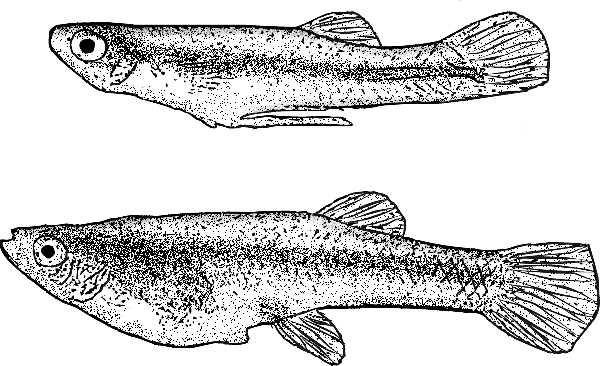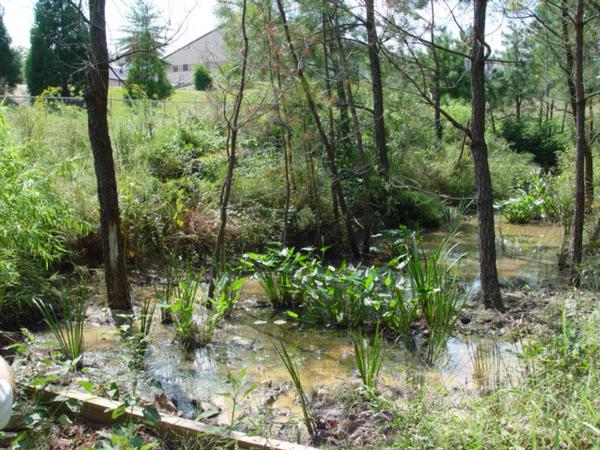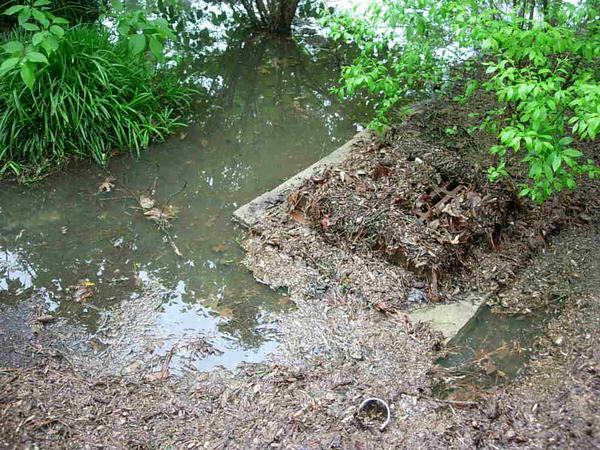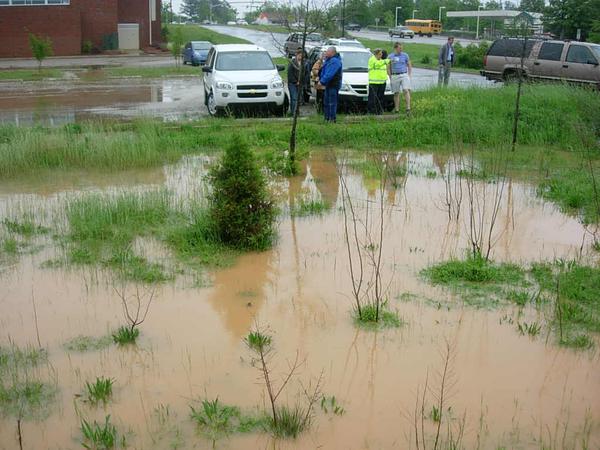Stormwater engineers and stormwater control measure (SCM) designers must evaluate and balance many goals when designing stormwater facilities. Among these are flood control, water quality, stream health, aesthetics, and mosquito control. Reports of mosquito-borne diseases, such as West Nile, encephalitis, and eastern equine encephalomyelitis, has provoked public concern about mosquitoes in stormwater facilities.
This publication summarizes some key facts that stormwater engineers and SCM designers should know as they design facilities and implement mosquito control measures. It also provides an overview of strategies for limiting mosquito populations in stormwater facilities.
Mosquito Populations in Stormwater Impoundments
Several studies conducted across the United States have evaluated the mosquito presence in stormwater facilities. Although the findings from these studies vary, as noted below, they document the presence of mosquitoes in many stormwater practices.
A 1979 study of 35 impoundments in New Jersey found mosquitoes present in 80 percent of the sampled wet ponds, dry ponds, and infiltration devices, such as sand filters. Mosquitoes were nearly as likely to be present in detention facilities (dry ponds), retention facilities (wet ponds), and infiltration devices.
A 1987 study in Illinois found very high mosquito counts in catch basins such as street inlets. This was attributed to both a lack of predators and a large amount of organic material in the basins studied. Accumulation of organic material is a common indicator of mosquito populations as it provides refuge from predators.
A 1993 study of 238 impoundments in Florida found mosquitoes present in nearly 90 percent of the sampled wet ponds, dry ponds, and infiltration basins.
A 2004 study of 52 impoundments in North Carolina found no mosquito larvae or pupae in more than 66 percent of the facility samples. It should be noted, however, that mosquito numbers were somewhat below average due to a relatively cool summer. Wetlands and innovative wet ponds (ponds with wetland zones) were more likely than standard wet ponds to have a higher number of mosquito species. The study was repeated in 2005 and produced similar results.
Informal observations in North Carolina indicate that sand filters often will not serve as mosquito breeding grounds because of the oil sheen that typically forms on top of the sedimentation chamber. The oil sheen interferes with the ability of mosquito larvae and pupae to breathe oxygen. Bioretention cells that function properly (drain as appropriate) have not had reported mosquito issues.
Studies in Australia and the United States have indicated that polluted water, such as water containing oil residuals, impedes mosquito growth.
The resources on the recommended reading list provide detailed information about studies conducted on mosquito populations in stormwater facilities.
Mosquito Types and Associated Diseases
All mosquitoes have two common requirements: They need water to complete their life cycle, and the larval and pupal stages must breathe oxygen. Some species can obtain oxygen from aquatic plants.
There are two main types of mosquito species: those that live in permanent and semi-permanent waters and those that live in temporary waters. Permanent and semi-permanent waters are found in a pond or wetland, where they are present except during drought periods. Pools of water that accumulate in low-lying areas during and immediately following a flood are examples of temporary waters. Mosquitoes need a minimum of four consecutive days of stagnant water for larvae to hatch to adulthood. Some species require up to six days.
Typically, the mosquito species that live in permanent and semi-permanent waters are those of concern in stormwater wetlands and wet ponds. In general, permanent water species lay eggs directly on the water’s surface. Their eggs hatch in about two to three days. A few species of permanent-water mosquitoes obtain oxygen directly from aquatic plants (for example, from Typha spp., commonly known as cattails).
The three most dominant species found in the North Carolina study were permanent-water species: Culex erraticus (present in 18 percent of the North Carolina facilities tested), Anopheles quadrimaculatus (9.4 percent), and Anopheles punctipennis (5.6 percent).
Temporary-water mosquito species, which include floodwater species, lay eggs in moist areas and wait for occasional floodwaters to inundate the eggs. Once this happens, eggs hatch and mosquito growth begins. Not surprisingly, infiltration devices (such as bioretention and infiltration basins) harbor a relatively large percentage of floodwater species. As infiltration devices slowly clog due to age and lack of maintenance, they can retain water long enough to allow floodwater mosquito pupae and larvae to reach maturity. The most common floodwater species in the 2004 North Carolina study was Aedes vexans, which was found in 3.2 percent of all facilities tested.
All the mosquito species found in the North Carolina study (14 in total) are known to be carriers of the West Nile virus. The mosquito found most often and in the greatest numbers in North Carolina stormwater facilities, Culex erraticus, is a vector for the eastern equine virus; the mosquito carries the virus without being affected by it.
This species feeds on both birds and mammals. Some birds are carriers for both West Nile and eastern equine viruses. Once a mosquito is infected by feeding on a bird that carries the virus, it can transmit the virus to large mammals (such as horses and people) when it takes another blood meal.
What Mosquitoes Want
Entomologists have studied mosquitoes extensively over the years and have found that they prefer a fairly simple set of conditions to thrive. SCM designers can minimize mosquito populations by denying mosquitoes what they want. The following conditions are favorable to mosquitoes:
- Still (not flowing) water
- Clear (not murky) water
- Cool (not warm) water
- Sufficient food
- Protection from predators
This publication provides guidance based upon taking away what mosquitoes want.
Mosquitofish and Other Predators
Research indicates that some ecological or biological controls can limit mosquito populations with varying degrees of success. In particular, mosquitofish (Gambusia affinis) are extremely effective at limiting mosquito population growth (Figure 1). Gambusia affinis is native to North Carolina, and the subspecies holbrooki occurs in the North Carolina mountains. Mosquitofish are amazingly tolerant. They can survive temperatures ranging from 33ºF to more than 100ºF. In addition, they can survive in a wide pH range (5 to 9.5) and in salinities as high as 15 parts per million (ppm).
Perhaps most amazing, the mosquitofish can live with dissolved oxygen levels of nearly 0.0 ppm. Its resilience in a wide range of environments makes the mosquitofish a good biological control for mosquitoes in some environments. Research in North Carolina indicates that sampled ponds and wetlands with mosquitofish present had significantly fewer occurrences of mosquitoes than those without the fish.
Because mosquitofish are resilient omnivores, however, they can have a detrimental impact on the diversity of a wetland or wet pond system. Their effect on populations of beneficial aquatic invertebrates—the many small insects, snails, and worms that nourish fish and other wildlife—is still being debated. Nevertheless, mosquitofish introduction is currently the only failsafe ecological measure for limiting mosquito population growth. Some predators, such as bats and purple martins, simply cannot eat enough mosquitoes to make any noticeable reductions. Moreover, purple martins have been found to eat another voracious mosquito predator, the dragonfly.
Locating SCMs to Limit Mosquito Impact
Another mosquito control involves where to locate a stormwater facility. Before a stormwater practice is designed and installed, the site should be considered. The facility should be located where any potential increase in the mosquito population is less likely to become a noticeable problem.
Select locations for stormwater practices where mosquitoes already live (such as a ditch). If a relatively large mosquito population exists in one part of the property but not in another, locate the SCM in the area where mosquitoes are already present. That way the SCM will not add a new mosquito habitat. For larger basins, this typically will not be an issue because most stormwater wetlands and wet ponds are located in the lowest and wettest part of the property to be cost-effective to the developer.
Wetland and Wet Pond Design and Management
Stormwater BMP designers can incorporate design features and management strategies inside stormwater wetlands and wet ponds that will limit mosquito growth.
Design Features. The most common design feature is the use of deep pools to encourage mosquito predators and water flow. Deep pools are integral to wetland design if mosquito control is a concern (Figure 2). Pools need to have a minimum water depth of 18 inches for mosquitofish survival. In this case, deeper is better; a 30-inch depth is preferable. Deep pools should be incorporated more frequently than has been traditionally prescribed. Several small deep pools will give mosquitofish easy access to shallow vegetation zones where they can prey upon mosquitoes.
When oriented perpendicularly to the main flow path, pools can help maintain sheet flow. This allows more surface area of the stormwater wetland or wet pond to receive flow. Flowing water is almost never likely to become a breeding site for mosquitoes.
In contrast, shallow pond zones (1 to 3 inches deep) that are disconnected from the general flow path are a potential mosquito habitat. If the shallow pools typically dry out in three to four days, the likelihood that mosquito larvae will survive and emerge as adults will be reduced. In addition, having isolated shallow areas that intersect the shallow water table should be avoided if these shallow areas are not accessible to fish from a deep pool.
While not every stormwater impoundment can support a fountain, the modest wave action created by fountains effectively minimizes zones where mosquitoes can proliferate. The NC Department of Environmental Quality (NC DEQ) provides some fountain selection guidance that is given at the end of this publication.
Management Strategies. Some studies have shown that a water-level drawdown of just 2 to 3 inches can significantly reduce mosquito populations. Because of this, prescribed drawdowns may effectively reduce mosquito populations. But this level of management is probably feasible only for very large stormwater wetlands and wet ponds with multiple-acre surface areas. This technique is commonly employed in wastewater treatment wetlands. A stormwater wetland and wet pond are designed for an occasional flood and drawdown. It is unclear what the impact of a typical stormwater wetland or wet-pond flooding and post-storm drawdown would be on mosquito populations. Keep in mind, however, that 52 facilities tested in North Carolina that employed a wetting-draw down cycle typically did not have mosquitoes.
Other Facility Concerns. Increased age and a lack of maintenance make stormwater facilities more likely to be mosquito sources than new and well-maintained facilities. This is probably due to the growth of vegetative species that are undesirable for mosquito control, as discussed in the vegetation section. Simple maintenance strategies, such as removal of unwanted plant species on an annual basis, are strongly recommended. Moreover, verifying that outlet structures are free flowing (and therefore not clogged) is critical.
Vegetation
Some types of vegetation help with mosquito control, while others exacerbate mosquito problems. Certain species of plants should be avoided in the initial planting plans for stormwater wetlands and wet ponds. As the facilities age, these same species may need to be removed on a regular basis, such as one time per year. Guidelines for select vegetation removal are provided in AG-588-07 Maintenance of Stormwater Wetlands and Wet Ponds.
Avoid a Wooded Overstory. A main finding from the North Carolina study was that the presence of woody plants in wetlands and wet ponds always corresponded to the presence of mosquitoes (Figure 3). This has important maintenance implications. One especially common woody species in North Carolina that will need to be removed is Salix nigra (black willow). This tree encourages mosquitoes because it provides shade to cool water and collects organic debris at its base, which serves as a refuge for mosquitoes from predators.
Certain herbaceous species of plants, however, have been identified as being attractive to mosquito predators, such as dragonflies. Some of these plants may also allow easier fish migration into the inner vegetation zones. Of these species, Pontederia latifolia is particularly recommended to be included on planting plans.
|
Scientific Name |
Common Name |
|
Nuphar lutea |
Spatterdock / Cow lily |
|
Nymphaea odorata |
Fragrant water lily |
|
Pontederia lancifolia |
Pickerelweed (narrowleaf) |
|
Pontederia latifolia |
Pickerelweed (broadleaf) |
|
Sagittaria latifolia |
Duck potato, arrowhead |
|
Sagittaria lancifolia |
Arrowhead |
|
Scirpus robustus |
Salt marsh bulrush |
NC DEQ has published wetland, wet pond, and bioretention plant selection guidance (see resources at the end of this document). This outstanding resource for vegetation selection for SCMs in North Carolina identifies species that promote mosquito predation.
Certain herbaceous species should be avoided because they do not provide good habitat for mosquito predators. Also, they may grow in such dense thickets that the vegetation blocks mosquitofish from reaching the inner portions of vegetation zones. Floating cattail mats, for example, have particularly high mosquito counts. These mats may help protect mosquito larvae from predatory fish.
|
Scientific Name |
Common Name |
|
Typha spp. |
Cattail |
|
Phragmites spp. |
Common reed |
Bioretention and Infiltration Device Design and Management
Infiltration and filtration-based SCMs, when functioning as designed, should normally not be mosquito habitats. As stated previously, mosquito pupae and larvae need at least four days of ponded water to emerge as adults. Bioretention and infiltration devices are designed to dewater in 12 hours to two days. Only in extremely wet periods would mosquitoes have the opportunity to reach adulthood. Bioretention drawdown rates are specifically limited to a range of 12 to 24 hours, which makes this SCM highly unlikely to support mosquito populations, provided it is maintained.
Maintenance. Clearly, maintaining drainage through a media, or into underlying soil, is key for these SCMs to avoid becoming mosquito breeding grounds. It is critical to verify (at least annually) that drawdown is occurring. This is simply done by visiting the practices the day after a moderately-sized event (0.8 to 1.2 inches). If a bioretention cell or infiltration basin still has water visibly ponded, the SCM is at risk of becoming a mosquito source during wetter periods (Figure 4).
The main cause of bioretention or infiltration device clogging is sediment from the catchment; this is usually associated with soil disturbance or decaying asphalt (Figure 5). Maintenance personnel should always alert property owners if large sediment loads appear to be entering these SCMs.
Summary
Research findings vary as to what percentage of stormwater impoundments currently provide good mosquito habitat. But there is no doubt about this: Where there is standing water, as in most stormwater facilities, there is a definite risk of mosquito presence. Stormwater control measure designers and managers have many useful tools to limit mosquitoes, including the introduction of mosquito predators, careful placement of the facilities, incorporation of design features preferred by mosquito predators, reliable maintenance and proper vegetation selection and control.
Resources
NC DEQ Plant Selection Guidance for SCMs
NC DEQ Wet Pond Minimum Design Criteria—Fountain Selection
Maintenance of Stormwater Wetlands and Wet Ponds (AG-588-07)
Recommended Reading
Batzer, D.P., and V.H. Resh. 1992. Wetland management strategies that enhance waterfowl habitats can also control mosquitoes. Journal of the American Mosquito Control Association. 8(2): 117-125.
Chanda, D.A., and J.K. Shishler. 1980. Mosquito control problems associated with stormwater control facilities. In Proc. of N.J. Mosquito Control Association. 67:193-200.
Collins, J.N., and V.H. Resh. 1989. Guidelines for the ecological control of mosquitoes in non-tidal wetlands of the San Francisco Bay area. California Mosquito Vector Control Association, Inc., and the University of California Mosquito Research Program. Sacramento, Calif.
Gamble, J.C. 1992. Mosquito control for stormwater managers. Wing Beats, Summer Issue: 5-7.
Geery, P.R., and R.E. Holub. 1989. Seasonal abundance and control of Culex spp. in catch basins in Illinois. Journal of the American Mosquito Control Association. 5(4):537-540.
Greenway, M; Dale, P; Chapman, H. 2003. An assessment of mosquito breeding and control in four surface flow wetlands in tropical-subtropical Australia. Water Science and Technology. 48(5): 249-256.
Hunt, W.F., C.S. Apperson, S.G. Kennedy, B.A. Harrison, W.G. Lord. 2006. Occurrence and relative abundance of mosquitoes in stormwater retention facilities in North Carolina, USA. Water Science and Technology. 54 (6-7): 315–321. https://doi-org.prox.lib.ncsu.edu/10.2166/wst.2006.625
Knight, R.L., W.E. Walton, G.F. O’Meara, W.K. Reisen, and R. Wass. 2003. Strategies for effective mosquito control in constructed treatment wetlands. Ecological Engineering. 21: 211-232.
Russell, R.C. 1999. Constructed wetlands and mosquitoes: Health hazards and management options—An Australian perspective. Ecological Engineering. 12:107-124.
Santana, F.J., J.R. Wood, R.E. Parsons, and S.K. Chamberlain. 1994. Control of mosquito breeding in permitted stormwater systems. Project #P179. Southwest Florida Water Management District, Brooksville, FL
Smith, C.M., and J.K. Shishler. 1981. An assessment of stormwater drainage facilities as sources of mosquito breeding. Mosquito News. 41(2): 226-230.
Acknowledgments
This publication has been revised from a previous version. The author would like to thank Charles S. Apperson, Shawn G. Kennedy, and William G. Lord for their prior contributions.
Publication date: July 9, 2020
AG-588-04
N.C. Cooperative Extension prohibits discrimination and harassment regardless of age, color, disability, family and marital status, gender identity, national origin, political beliefs, race, religion, sex (including pregnancy), sexual orientation and veteran status.






